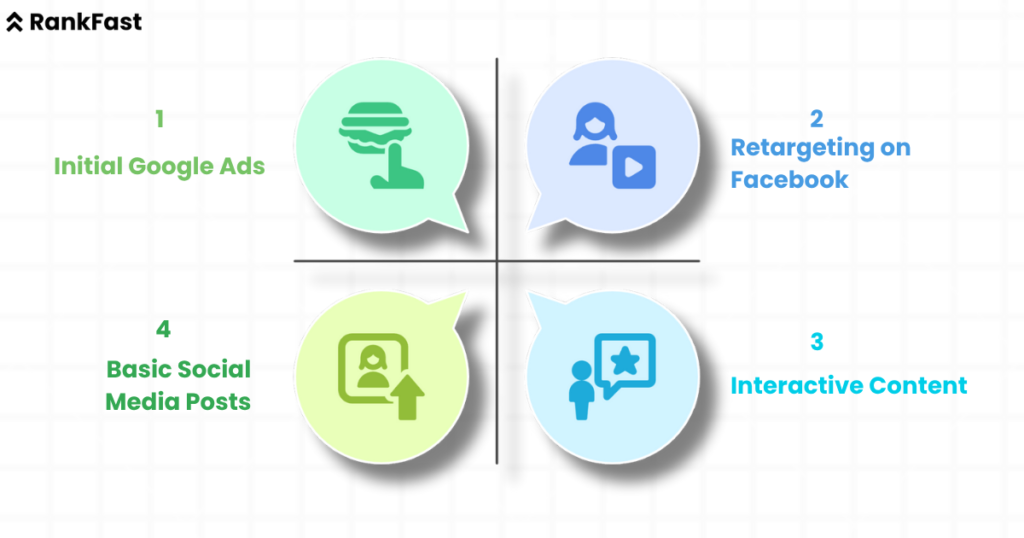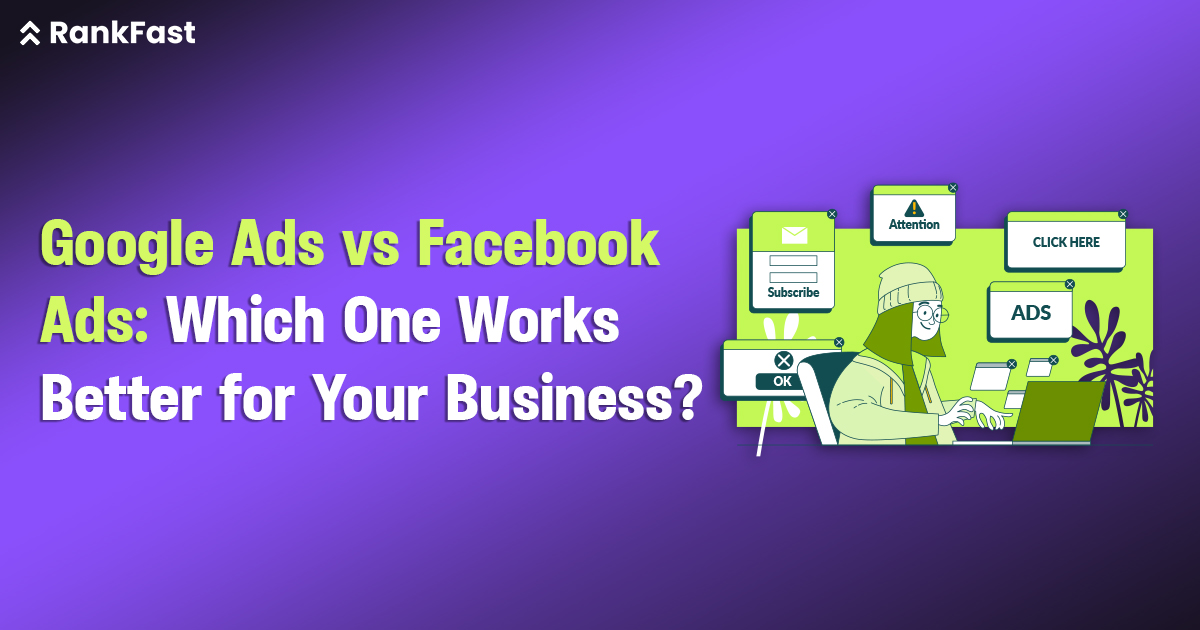Running ads, spending money, but no real leads? Many business owners make the same mistake, picking a platform based on popularity, not fit. Google Ads vs Facebook Ads: Both platforms can work. But what works for an ecommerce store may fail for a service business.
Even though Facebook’s global ad revenue is expected to touch $116.53 billion by the end of 2025, it’s not always the right choice. In this blog, we explain which is better: Facebook Ads or Google Ads in 2025.
What Are Google Ads?
Google Ads is a pay-per-click advertising platform by Google. It shows your ads across its network, Search, YouTube, Display, and Shopping. You pay when someone clicks on your ad. That’s why it’s often called performance marketing.
Most users on Google are already looking for something. That’s high-intent traffic. For example, a person searching for “AC repair near me” is ready to book or call. Google Ads puts your offer directly in front of such buyers.
There are four major types:
- Search Ads: Text ads on Google search results.
- Display Ads: Banners on sites within Google’s Display Network.
- Shopping Ads: Product listings with images and prices.
- Video Ads: Ads on YouTube.
In Q1 2025, Google made $66.89 billion from ads alone, which was 8.5% higher than Q1 2024. That amount formed around 75% of Alphabet’s total revenue. This tells us how deeply businesses trust Google Ads to deliver results.
Most B2B and B2C service brands use it for its search-based targeting and measurable ROI. With enough budget control and keyword research, it suits businesses needing leads fast.
What Are Facebook Ads?
Facebook Ads (now under Meta Ads Manager) lets you run paid ads across Facebook, Instagram, Messenger, and Audience Network. Unlike Google, people here don’t search. They scroll. So, these ads interrupt user activity, but can still work if crafted right.
Facebook Ads are visually heavy. You choose who sees your ads based on age, gender, interests, and behaviour. That makes it ideal for discovery-based marketing.
Major formats include:
- Image Ads
- Video Ads
- Carousel Ads
- Lead Forms
- Stories & Reels Ads
You can also retarget users who saw your previous posts, visited your website, or added items to a cart but didn’t buy.
Facebook works best for brand awareness, product promotions, and community engagement. It’s not ideal for emergency services or time-sensitive buying intent.
Its audience size, data-driven targeting, and mobile-first design make it attractive for businesses focused on lifestyle, fashion, beauty, education, and home décor sectors.
Google Ads vs Facebook Ads: Key Differences
Understanding how Google Ads vs Facebook Ads function can help you allocate budget and boost ROI:
| Factor | Google Ads | Facebook Ads |
| User Intent | High, users search with a need | Low, users discover passively |
| Audience Targeting | Keyword + location | Demographics + interests |
| Ad Format | Text, Shopping, Video | Image, Video, Carousel, Story |
| Platform Reach | Search, YouTube, Gmail, Display Network | Facebook, Instagram, Messenger, Audience Network |
| Conversion Type | Lead forms, calls, and purchases | Engagement, lead forms, traffic, catalog sales |
| Best For | Services, search queries, quick actions | Visual brands, ecommerce, event promos |
| Budget Control | Full bid strategy + device control | Budget per ad set, no keyword bidding |
| Remarketing Tools | Display and Search retargeting | Retargeting via Pixel and custom audiences |
Understanding this PPC platform comparison will guide you better than guessing based on popularity.
Targeting Options
Google Ads targets users through keywords, location, device, time, and audience behaviour. If you’re running a dental clinic in Chennai, you can target “dentist near me” for mobile users within a 5 km radius during business hours.
You can also create custom intent audiences or use remarketing lists to show ads to people who visited certain pages or clicked your offers.
Facebook Ads goes deeper into lifestyle-based targeting. You can target:
- Relationship status (engaged, married)
- Hobbies (biking, cooking)
- Purchase behaviour
- Pages liked or posts interacted with
For instance, a new bakery in Bangalore can run birthday cake ads targeting people turning 30–40 next week. These layers of filters make Facebook powerful for visual and lifestyle-based products.
But targeting alone doesn’t win. You need matching creativity. If your copy doesn’t fit the target user’s life stage or pain, it won’t convert.
User Intent
Intent is what separates Google Ads from Facebook Ads. People on Google already want something. They need answers, products, and solutions. That’s why conversions tend to be quicker.
On Facebook, users don’t have that intent. You need to create desire. That takes strong visuals, storytelling, and trust.
For example:
- “Buy Air Purifier Chennai” on Google = direct buying intent.
- Showing an air purifier ad on Facebook = passive viewing. You might get likes or saves, but not always sales.
In short:
- Use Google for high-intent, ready-to-buy users.
- Use Facebook to build curiosity, showcase lifestyle, or retarget warm leads.
Ad Formats
Google Ads focuses on text and functional layouts. People see it as a utility. Most used:
- Responsive search ads
- Call-only ads
- Product shopping ads
- Display banners
Facebook offers interactive and emotional storytelling:
- Swipeable carousels
- Videos with captions
- Dynamic product ads
- Instant experience (formerly Canvas)
Each platform demands a different creative mindset. Google = clarity and offer. Facebook = emotion and story.
A laptop store should use Google Ads for “best budget laptops under 40K” and use Facebook for “student laptops giveaway contest.”
Cost Comparison
Google Ads usually costs more per click, especially in finance, law, or tech. CPC can range from ₹15 to ₹150 depending on the competition.
Facebook Ads give cheaper CPCs, sometimes below ₹5. But cheaper doesn’t mean better. Clicks from people without buying intent are not useful.
If you want quick leads, Google gives faster ROI. But for building an email list or promoting a low-cost product, Facebook may stretch your budget better.
Use A/B testing and control the budget per ad group. Facebook needs fresher creatives. Google needs cleaner landing pages.
Conversion Performance
Conversion depends on what you sell and who you sell to.
Google Ads:
- Higher CTRs for urgent needs
- Better for calls, forms, and store visits
- Works faster with optimized landing
Facebook Ads:
- Higher conversion for visuals like apparel, jewellery, food
- Better at retargeting
- Needs a better nurturing funnel
Track events via Facebook Pixel or Google Tag Manager. Optimize for actions, not impressions.
For lead gen campaigns, always test the landing page vs the lead form. Facebook forms get volume, but not always quality.
Analytics & Reporting
Google Ads uses Google Analytics, Search Console, and built-in reports. Metrics include:
- Quality score
- Impression share
- Conversion rate by keyword
Facebook Ads uses Meta Business Suite. Reports cover:
- Reach
- Engagement
- Frequency
- Clicks by placement
Both give real-time insights. But when it comes to Google Ads vs Facebook Ads, Google has better control and tracking options for attribution models.
For custom dashboards, use tools like Data Studio or Looker.
Which Platform Is Best for Your Business Type?
Ecommerce
Use Facebook for catalog ads, retargeting, and upselling. Dynamic creatives perform well here. Combine it with Google Shopping for maximum product visibility.
Local Businesses
Google Ads is the best. People searching “car repair near me” convert faster than casual Facebook users. Use call-only ads and maps extensions.
B2B vs. B2C
- B2C: Use both, but lean on Facebook for product exposure.
- B2B: Go with Google Ads for targeted keyword queries and LinkedIn for deeper segmentation.
Service Providers
Google Ads helps service professionals like lawyers, plumbers, or consultants. Facebook may assist with brand trust, but it doesn’t convert as quickly for urgent services.
When to Use Both (Omnichannel Strategy)
If you have a budget and bandwidth, use both platforms to support each other. Start with Google to capture active leads. Retarget them on Facebook with educational videos, reviews, or case studies.

You can also:
- Drive cold traffic from Facebook to blog pages.
- Retarget warm leads through the Google Display Network.
- Collect emails via Facebook forms and remarket via YouTube.
Omnichannel works best when your funnel is long and your product is mid to high ticket.
Final Thoughts
Choosing between Google Ads vs Facebook Ads depends on your goals, budget, and business type. Use Google when buyers are searching. Use Facebook when you need discovery, engagement, or remarketing. You don’t have to pick one forever. Test, track, and optimize. Results come when you align platform strength with your audience’s needs.
At RankFast, we help businesses pick the right PPC platform, manage campaigns, and improve ROI without guesswork. Let’s plan your growth now.
FAQs
1. Which is better: Facebook Ads or Google Ads in 2025?
Google Ads works better for high-intent search. Facebook is better for brand awareness, visual products, and retargeting. Use based on your goals.
2. Are Facebook Ads cheaper than Google Ads?
Yes, the cost per click is usually lower on Facebook. But cheap clicks don’t always mean conversions. Choose based on conversion, not just cost.
3. Can I use both platforms together?
Yes. Google for active buyers, Facebook for retargeting and nurturing. This combined strategy increases total reach and lifetime value.
4. Is Google Ads better for service businesses?
Yes. Service buyers often search on Google with urgency. Keywords like “emergency plumber” convert better on Google than on Facebook.
5. Do I need a big budget for ads?
Not always. Start with ₹500/day, test audiences and creatives. Optimize campaigns weekly. Scale only when you see real conversions.

Leave a Reply